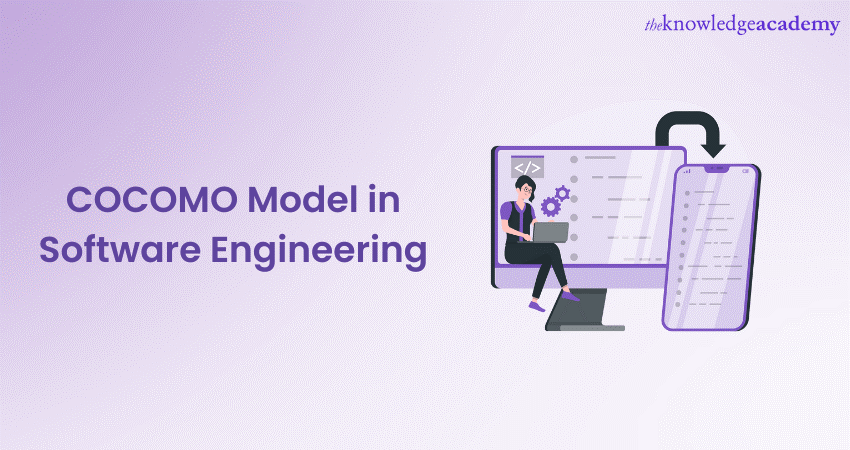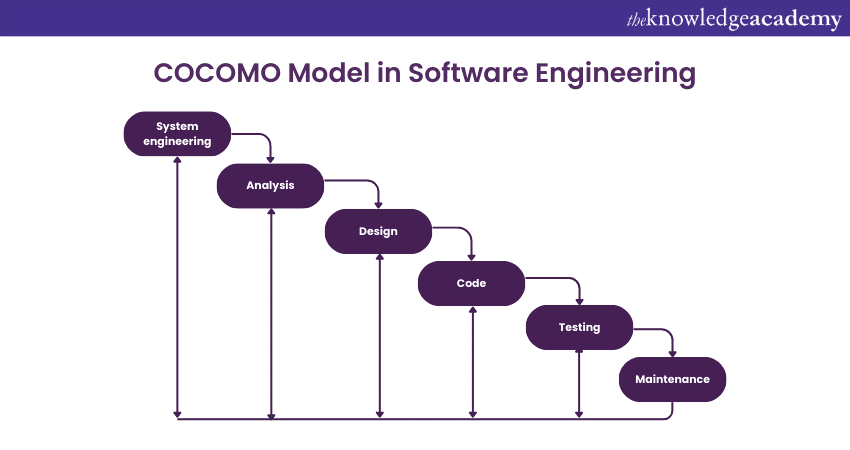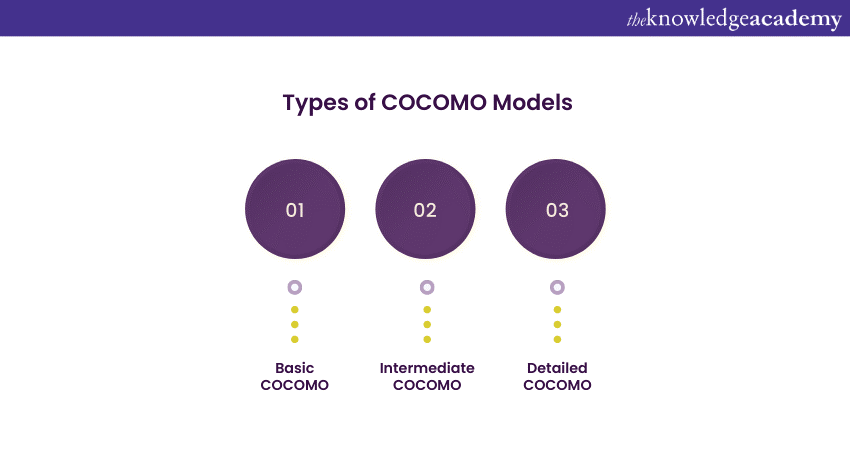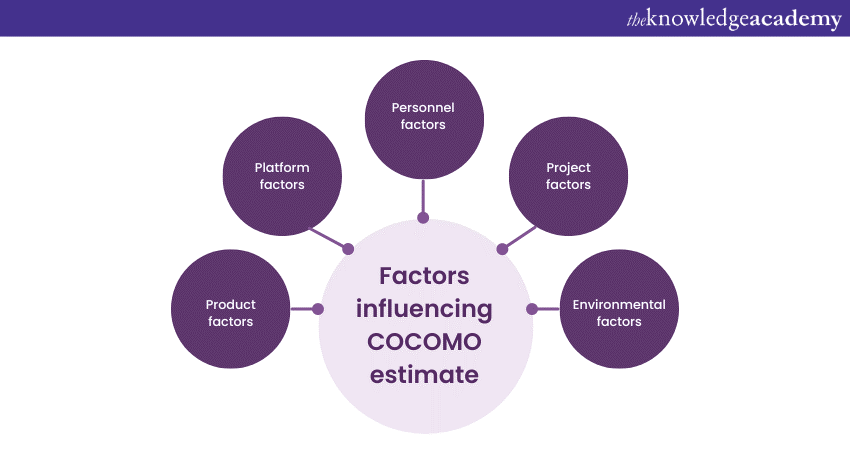We may not have the course you’re looking for. If you enquire or give us a call on 01344203999 and speak to our training experts, we may still be able to help with your training requirements.
Training Outcomes Within Your Budget!
We ensure quality, budget-alignment, and timely delivery by our expert instructors.

Software Project Estimation shapes resource allocation, timelines, and costs. COCOMO Model (Constructive Cost Model) is a cornerstone in Software Project Estimation. This model gauges effort, duration, and price, adapting to evolving software complexities.
In this blog, we will talk about the COCOMO Model in Software Engineering and its approach to Software Development that enhances cost estimation & paves the way for successful project outcomes.
Table of Contents
1) What is the COCOMO Model?
2) Types of COCOMO Models
3) COCOMO Model components
4) COCOMO calculation process
5) Factors influencing the COCOMO estimate
6) Advantages of the COCOMO Model
7) Limitations of the COCOMO Model
8) Real-world applications of the COCOMO Model
9) Conclusion
What is the COCOMO Model?

The renowned Software Estimation technique, COCOMO, is pivotal in Project Management. Introduced by Dr. Barry Boehm, the COCOMO Model offers accurate estimates for the resources, time, and costs required for Software Development projects. It operates based on the principle that different Software Projects possess varying levels of complexity and characteristics, thereby influencing the effort and resources needed.
Unlock your potential in Software Engineering with our Software Engineering Training Program and master the art of building innovative Applications.
Types of COCOMO Models

COCOMO Model in Software Engineering encompasses three distinct types, each tailored to address varying project complexity and intricacy levels. These models provide a structured framework to estimate software development's effort, time, and costs, enabling informed decision-making in Project Management.
Basic COCOMO
This Basic COCOMO Model is ideal for early-stage estimates. It estimates effort based solely on the size of the code to be developed. The central parameter here is the Source Lines of Code (SLOC). Basic COCOMO assumes a linear relationship between project size and effort. It's a simplistic yet useful approach for quick ballpark estimates in the initial project stages.
Intermediate COCOMO
As projects become more intricate, Intermediate COCOMO introduces influencing factors that impact the estimation process. These factors include product characteristics, platform attributes, personnel skills, project complexity, and development environment. Intermediate COCOMO employs cost drivers to adjust the estimation based on these factors, making it more accurate than the Basic Model.
Detailed COCOMO
Designed for complex and large-scale projects, Detailed COCOMO delves even deeper into estimation parameters. It encompasses a comprehensive set of factors, including those from Intermediate COCOMO, and additional considerations such as risk assessment, team cohesion, and Project Management capabilities. Detailed COCOMO employs extensive cost drivers and scales to provide a highly refined and nuanced estimation, making it suitable for projects with intricate requirements and diverse variables.
COCOMO Model components
The COCOMO Model comprises several integral components that collectively enable accurate estimation of Software Development project effort, time, and costs. Understanding these components is crucial for Project Managers and Software Engineers to make informed decisions, allocate resources effectively, and ensure the successful execution of projects.
Source Lines of Code (SLOC)
This fundamental component serves as the foundation for COCOMO's size-based estimation. SLOC quantifies the size of the Software Project by counting the number of lines of code to be written. It directly influences the effort required for development, forming the basis for early-stage estimates in Basic COCOMO.
Effort estimation
Estimating effort involves predicting the human resources required to develop the software. It considers factors such as team size, expertise, and skill levels. Effort estimation constitutes the core purpose of COCOMO, ensuring adequate staffing for the project and efficient distribution of tasks.
Unlock your coding potential with our Java Programming and Software Engineering Fundamentals Training. Master Java and build a solid foundation in Software Engineering!
Duration estimation
Duration estimation focuses on predicting the time required to complete the project. It considers the project's complexity, team productivity, and resource allocation. Accurate duration estimation aids in effective project scheduling and timely delivery.
Cost estimation
Cost estimation consists of the Software Project's monetary and resource costs. It includes personnel costs, hardware and software costs, overhead expenses, and potential risks. Proper cost estimation aids in budgeting and planning, preventing unexpected financial constraints
COCOMO calculation process
The COCOMO Model calculation process systematically enables Software Project Managers and engineers to estimate effort, time, and costs accurately. This process involves a series of steps, each tailored to different COCOMO variants, ensuring a comprehensive and detailed estimation.
Step 1: Size estimation
The first step involves quantifying the size of the Software Project. In Basic COCOMO, developers accomplish this by utilising Source Lines of Code (SLOC). In Intermediate and Detailed COCOMO, the estimation considers alternative size measures, such as Function Points or Object Points. The selected size metric mirrors the project's complexity and forms a foundation for subsequent calculations.
Step 2: Effort estimation
Once the project size is determined, the effort required for development is estimated. The basic COCOMO Model uses a simple linear relationship between SLOC and action. Intermediate COCOMO introduces a set of cost drivers that adjust the effort based on influencing factors like team capability, development environment, and product complexity. Detailed COCOMO refines the effort estimation by considering additional parameters such as risk assessment and team cohesion.
Step 3: Duration estimation
With effort estimation in place, we predict the project's duration. We accomplish this by dividing the effort by the number of available resources. The outcome is the project's estimated duration, considering the team's productivity and size.
Step 4: Cost estimation
The last step involves calculating the project's cost. It includes direct costs, such as personnel salaries and hardware expenses, and indirect costs, like overhead and potential risks. The cost estimation provides a comprehensive view of the financial aspects of the project, aiding in budget allocation and financial planning.
Factors influencing the COCOMO estimate

The COCOMO Model estimates' accuracy depends on various factors that together affect the complexities of a Software Project. These factors, categorised into five distinct groups, are pivotal in refining the estimation process and ensuring that Project Managers and Engineers make informed decisions.
Product factors
The estiation is significantly affected by the nature of the software. Factors like the product's complexity, degree of innovation, required performance, and expected reliability impact the effort, time, and cost involved. Projects featuring intricate functionalities or advanced features may require more resources and time for development.
Platform factors
The platform on which the software will operate also contributes to the estimation process. Considerations like compatibility with existing systems, hardware limitations, and software tools influence the effort required. Platform factors account for the adaptability and integration complexities that affect development efforts.
Unlock the power of seamless Software creation –Join now in our comprehensive Software Development Lifecycle Training and elevate your Development skills today!
Personnel factors
The capabilities and experience of the development team influence project estimates. The skill levels, familiarity with the technology stack, and team cohesion impact productivity. An experienced and well-coordinated team might accomplish tasks more efficiently, affecting effort and time estimates.
Project factors
The scope and structure of the project, including its size and complexity, influence the estimation process. A project's organisational and managerial attributes, like communication effectiveness and the presence of precise requirements, can affect the development process and thus, the estimates.
Environmental factors
Factors such as regulatory constraints, market competition, and resource availability shape software estimates within the external environment. These external conditions influence the project's timeline and costs, contributing to the overall risk and uncertainty associated with the project.
Advantages of the COCOMO Model
COCOMO Model holds several distinct advantages that have contributed to its prominence as a reliable and widely used Software Estimation technique. These advantages underscore its value in guiding Project Management decisions and enhancing the overall Software Development process.
1) Structured estimation: COCOMO offers a systematic and structured framework for estimating effort, time, and costs. Its three variants cater to different project complexities, tailoring estimation to the unique characteristics of each project. This structured approach enhances estimate accuracy and enables more realistic project planning.
2) Informed decision-making: COCOMO's comprehensive consideration of influencing factors, such as product, platform, personnel, project, and environmental factors, equips Project Managers and Engineers with a holistic understanding of project dynamics. This information empowers informed decision-making, enabling stakeholders to anticipate challenges, allocate resources effectively, and set realistic project goals.
3) Flexibility: COCOMO's flexibility allows it to accommodate various Software Projects, from small-scale to large-scale, simple to complex. It can be adapted to multiple development methodologies and technologies, making it applicable in diverse Software Engineering environments.
4) Benchmarking and communication: COCOMO's standardised estimation process facilitates stakeholder benchmarking and communication. By providing a common language for estimating and discussing project requirements, COCOMO promotes clarity and transparency, reducing the potential for misunderstandings and conflicts.
6) Risk assessment: The COCOMO Model inherently considers risk factors, especially in the Intermediate and Detailed versions. It helps identify potential risks early in the project lifecycle and allows for proactive risk management strategies
7) Educational value: COCOMO's structured approach and precise components make it an educational tool. It aids Software Engineering students and professionals understand the various facets of project estimation, contributing to their skill development.
8)Historical data utilisation: COCOMO can leverage historical data from previous projects to refine estimates. By analysing past project data, organisations can enhance the accuracy of their future estimations.
Limitations of the COCOMO Model
While COCOMO Model stands as a valuable Software Estimation technique, it is not without its limitations. Recognising these constraints is essential for Project Managers and Software Engineers to make well-informed decisions and to supplement COCOMO with additional approaches when necessary.
1) Sensitivity to initial estimates: COCOMO's accuracy relies on the initial estimates of project size, often measured in Source Lines of Code (SLOC). If the initial size estimate is correct, the entire estimation can lead to accurate effort, time, and cost predictions.
2) Assumption of linearity: Basic COCOMO assumes a linear relationship between project size and effort, which might not hold for all projects. Complex projects may exhibit nonlinear patterns, rendering Basic COCOMO less accurate for these cases.
3) Complexity assessment: Assessing project complexity is subjective and can vary among estimators. Factors such as individual judgment and interpretations of influencing parameters can introduce variability in estimates.
4) Lack of consideration for modern practices: COCOMO was developed in the late 1970s and may only partially accommodate modern Software Development practices, such as Agile methodologies, emphasising iterative and incremental development.
5) Risk assessment limitations: Intermediate and Detailed COCOMO versions incorporate risk assessment. However, the model may only comprehensively cover some potential risks and their effectiveness.
6) Scope changes: COCOMO estimates assume a stable scope throughout the project, which can be problematic when projects undergo significant changes or feature additions.
7) Limited hardware consideration: While COCOMO factors in platform attributes, it may need to adequately capture the nuances of modern hardware and cloud computing environments.
Unlock the power of Agile methodologies and elevate your Software Development skills with our comprehensive Agile Software Development Training.
Real-world applications of the COCOMO Model
COCOMO Model has found widespread application in various real-world scenarios, demonstrating its value in guiding Software Project estimation and management.
1) Industry projects: Numerous industries, from finance to healthcare, have successfully employed COCOMO for estimating resources, time, and costs in Software Development. It aids in setting realistic project goals, managing budgets, and ensuring timely deliveries.
2) Government initiatives: In highly regulated and safety-critical sectors like aerospace and defence, COCOMO helps predict the effort and costs needed for Software Development in systems like avionics and missile control.
3) Aerospace and defence: In highly regulated and safety-critical sectors like aerospace and defence, COCOMO helps predict the effort and costs needed for Software Development in systems like avionics and missile control.
4) Enterprise solutions: Large corporations use COCOMO to estimate the scope and effort required for the implementation of enterprise-level software systems, such as ERP (Enterprise Resource Planning) and CRM (Customer Relationship Management) solutions.
5) Healthcare software: COCOMO assists in estimating the resources needed to develop Electronic Health Record (EHR) systems, medical imaging software, and telemedicine applications.
6) Gaming industry: In the gaming industry, where software complexity and graphical elements are paramount, COCOMO aids in predicting the effort and costs associated with game development.
7) Infrastructure software: Software used for managing critical infrastructure, such as energy distribution, water supply, and transportation systems, benefits from COCOMO's estimation capabilities.
8) Web and mobile applications: COCOMO is also applied to estimate development efforts for web and mobile applications, facilitating effective resource allocation and project planning.
9) Academic research: COCOMO's structured approach has been used in academic research to analyse and evaluate the feasibility of Software Projects, contributing to the advancement of Software Engineering knowledge.
Conclusion
The COCOMO Model stands as a robust and adaptable Software Estimation tool. With its structured framework and consideration of influencing factors, COCOMO Model in Software Engineering empowers informed decision-making, accurate resource allocation, and effective project planning, making it an invaluable asset.
Frequently Asked Questions
Upcoming Programming & DevOps Resources Batches & Dates
Date
 Systems Engineering Training
Systems Engineering Training
Fri 26th Jul 2024
Fri 25th Oct 2024
Wed 5th Mar 3034







 Top Rated Course
Top Rated Course



 If you wish to make any changes to your course, please
If you wish to make any changes to your course, please


